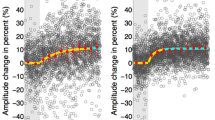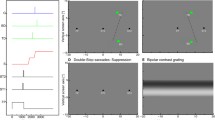Abstract
Accuracy of four different types of memory-guided saccades was studied in two patients with a small central thalamic lesion, probably involving the region of the internal medullary lamina (IML), and in a control group. In the first paradigm, the eyes and head remained immobile between the time of the presentation of the visual target to be remembered and the memory-guided saccade. In the other three paradigms, the eyes were displaced during the same period (before the memory-guided saccade) by either visually-guided saccades, a smooth pursuit eye movement or a body movement (with vestibulo-ocular reflex suppression). Therefore, in these three paradigms, the initial eye displacement required the use of extraretinal eye position to produce accurate memory-guided saccades. Compared with the control group, the two patients had normal accuracy in the first memory-guided saccade paradigm, in which there was no initial eye displacement, but markedly impaired saccade accuracy in the other three paradigms. These results suggest that the cortical areas triggering saccades did not receive correct extraretinal eye position signals. They are consistent with an impairment of the efference copy, which could be distributed to the cortical ocular motor areas by the IML.
Similar content being viewed by others
References
Albano JE, Wurtz RH (1982) Deficits in eye position following ablation of monkey superior colliculus, pretectum and posterior-medial thalamus. J Neurophysiol 48:318–337
Asanuma C, Thach WT, Jones EG (1983) Anatomical evidence for segregated focal groupings of efferent cells and their terminal ramifications in the cerebellothalamic pathway of the monkey. Brain Res Rev 5:267–297
Barbas H, Mesulam MM (1985) Cortical afferent input to the principalis region of the rhesus monkey. Neuroscience 15:619–637
Büttner-Ennever JA, Henn V (1976) An autoradiographic study of the pathways from the pontine reticular formation involved in horizontal eye movements. Brain Res 108:155–164
Chain F, Leblanc M, Chédru F, Lhermitte F (1979) La négligence visuelle dans les lésions postérieures de 1'hémisphère gauche. Rev Neurol (Paris) 135:105–126
Cramon D von, Zihl J (1979) Roving eye movements with bilateral symmetrical lesions of the thalamus. J Neurol 221:105–112
Goldberg ME, Bruce CJ (1990) Primate frontal eye fields. III. Maintenance of a spatially accurate saccade signal. J Neurophysiol 64:489–508
Guthrie BL, Porter JD, Sparks DL (1983) Corollary discharge provides accurate eye position information to the oculomotor system. Science 221:1193–1195
Jeffers IM, Schlag-Rey M, Schlag J (1987) Anatomical connections of the supplementary eye field (SEF). Invest Ophthalmol Vis Sci [Suppl] 28:22
Kaufman ES, Rosenquist AC (1985) Afferent connections of the thalamic intralaminar nuclei in the cat. Brain Res 335:281–296
Kotchabhakdi N, Rinvik E, Walberg F, Yingchareon K (1980a) The vestibulothamic projections in the cat studied by retrograde axonal transport of horseradish peroxidase. Exp Brain Res 40:405–418
Kotchabhakdi N, Rinvik E, Yingchareon, F Walberg (1980b) Afferent projections to the thalamus from the perihypoglossal nuclei. Brain Res 187:457–461
Lewis RF, Zee DS (1993) Abnormal spatial localization with trigeminal-oculomotor synkinesis: evidence for a proprioceptive effect. Brain 116:1105–1118
Lewis RF, Zee DS, Gaymard BM, Guthrie BL (1994) Extraocular muscle proprioception functions in the ocular alignment and eye movement conjugacy. J Neurophysiol 72:1028–1031
Matthews PBC (1988) Proprioceptors and their contribution to somatosensory mapping: complex messages require complex processing. Can J Physiol Pharmacol 66:430–438
McCrea RA, Baker R (1985) Anatomical connections of the nucleus prepositus of the cat. J Comp Neurol 237:377–407
Schlag J, Schlag-Rey M, Peck CK, Joseph JP (1980) Visual responses of thalamic neurons depending on the direction of gaze and the position of targets in space. Exp Brain Res 40:170–184
Schlag-Rey M, Schlag J (1984) Visuomotor functions of the central thalamus in monkey. I. Unit activity related to spontaneous eye movements. J Neurophysiol 51:1149–1174
Schlag-Rey M, Schlag J (1989) The central thalamus. In: Wurtz RH, Goldberg ME (eds) The neurobiology of saccadic eye movements. Elsevier Science, Amsterdam, pp 361–390
Schlag-Rey M, Jeffers I, Schlag J (1987) Central thalamus and supplementary eye field sites for goal-directed saccades have reciprocal connections. Invest Ophthalmol Vis Sci [Suppl] 28:333
Selhorst JB, Stark L, Ochs AL, Hoyt WE (1976) Disorders in cerebellar ocular motor control. I. Saccadic overshoot dysmetria, an oculographic, control system and clinico-anatomic analysis. Brain 99:497–508
Stanton GB, Bruce CJ, Goldberg ME (1982) Organization of subcortical projections from saccadic eye movement sites in the macaque's frontal eye fields. Soc Neurosci Abstr 8:293
Author information
Authors and Affiliations
Rights and permissions
About this article
Cite this article
Gaymard, B., Rivaud, S. & Pierrot-Deseilligny, C. Impairment of extraretinal eye position signals after central thalamic lesions in humans. Exp Brain Res 102, 1–9 (1994). https://doi.org/10.1007/BF00232433
Received:
Accepted:
Issue Date:
DOI: https://doi.org/10.1007/BF00232433




